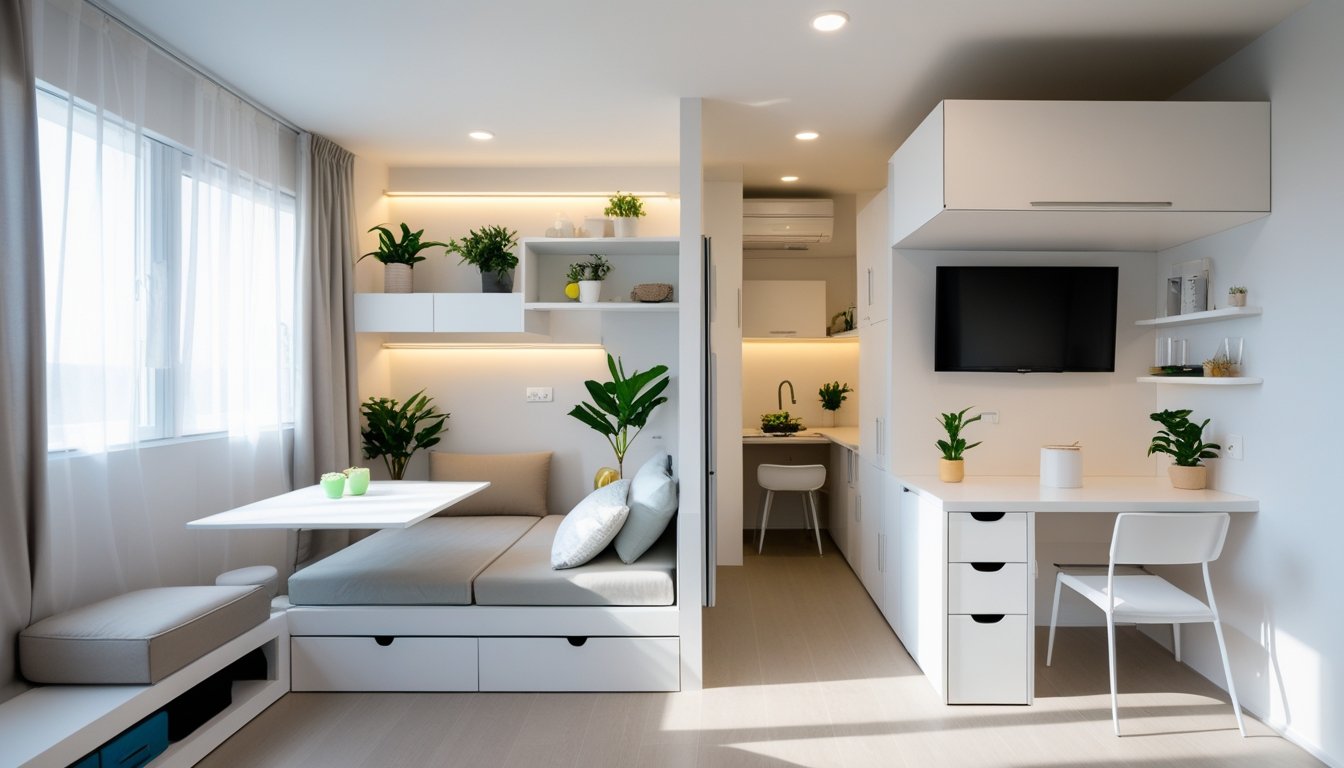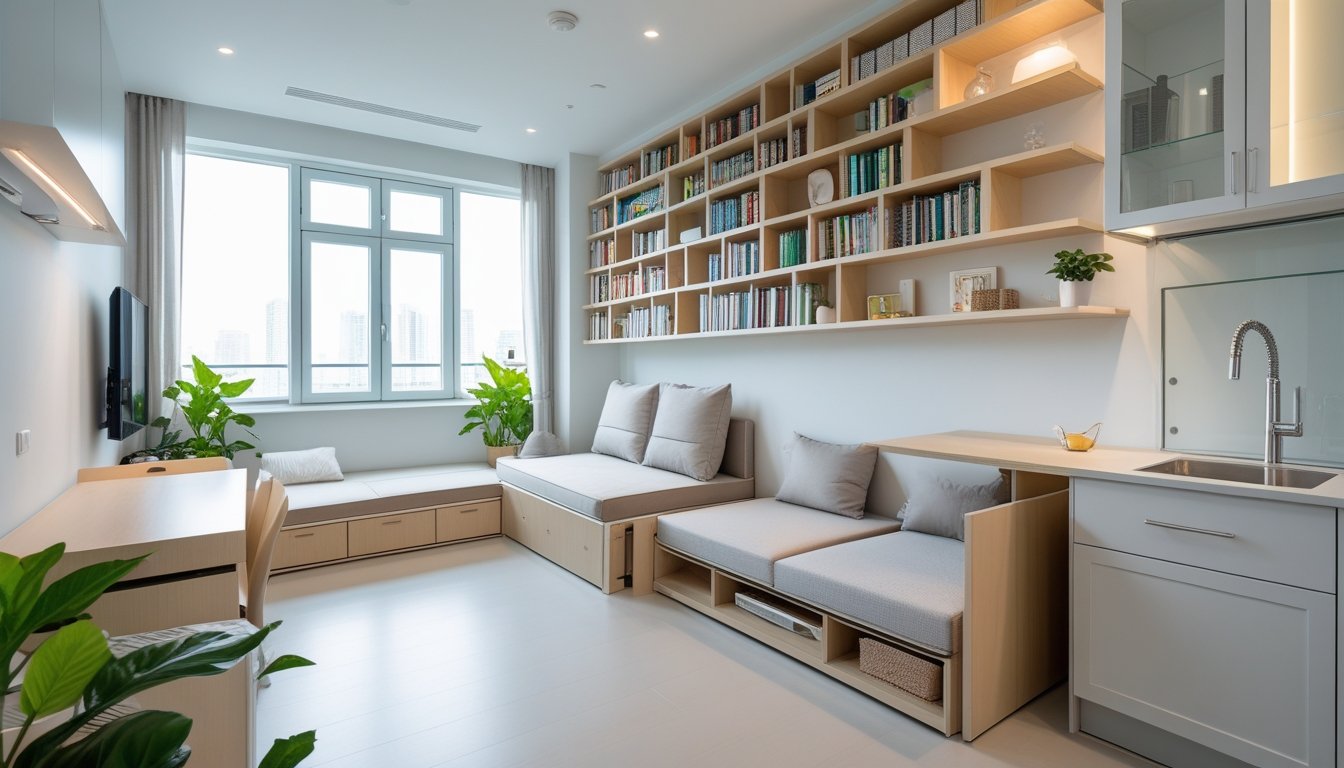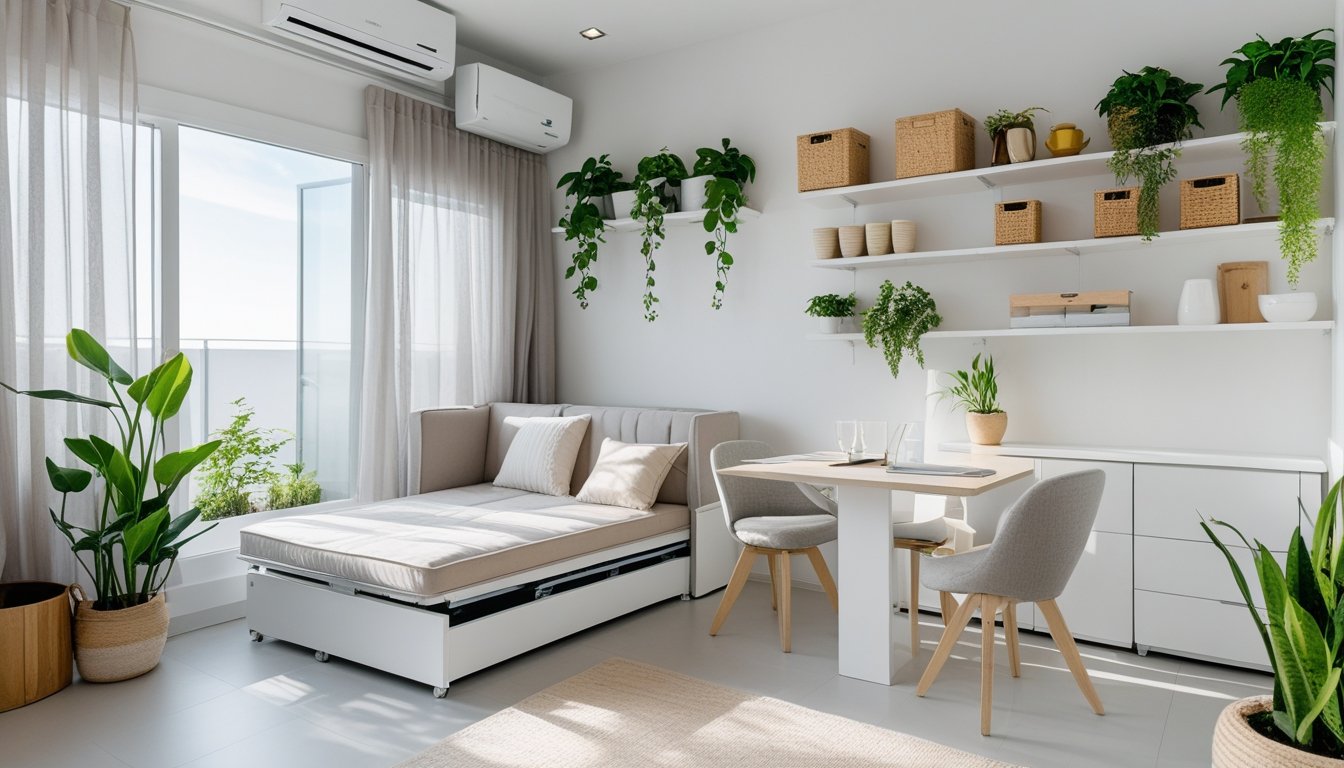Late updated: 12 Nov 2025 10:11
Written by: Daniel Harper
Innovative Techniques For Maximising Small Living Spaces: Creative Solutions For Compact Homes
Navigating the world of compact living can indeed present a unique set of challenges, as limited square footage often demands creative solutions. Yet, the rewards extend beyond mere practicality to include aesthetic innovation and a heightened sense of satisfaction when space is maximised effectively. The key lies in developing strategies that combine multifunctional furniture, clever storage, and intelligent design elements to evoke a sense of openness and flow.

As urban living spaces continue to shrink, especially in bustling cities, the traditional large home is rapidly becoming a luxury, rather than the norm. For those of us adapting to the constraints of a studio apartment or tiny home, the need for innovative techniques becomes apparent. From wall-mounted shelving to adaptable furniture and strategic lighting, each small change can significantly impact the overall feel and functionality of our living environments.
The goal isn't simply to fit everything within the confines of four walls but to transform these spaces into personal havens that resonate with warmth and efficiency. By integrating smart design principles and creativity, we tap into the potential to turn limitations into opportunities, creating a living space that is both comfortable and reflective of our style.
Key Takeaways
- Multifunctional furniture and clever storage can maximise small spaces.
- Design elements such as strategic lighting create a sense of openness.
- Adapting smart principles turns limitations into opportunities.
Core Strategies for Maximising Small Living Spaces

Effectively managing limited living areas requires strategic approaches to maximise functionality and style. Our focus will be on decluttering, selecting versatile furniture, and employing innovative storage solutions. These methods aim to transform any compact space into a comfortable and efficient environment.
Decluttering for Enhanced Functionality
Decluttering is the first step in improving small spaces. Removing unnecessary items creates a sense of openness and enhances usability. By evaluating which belongings are essential, we can eliminate clutter and free up valuable space. Consider embracing a minimalist approach, ensuring each item serves a purpose.
Streamlined organisation allows for better movement and flow, making the space more attractive and functional. Utilising vertical storage options like shelves or hooks can also help keep surfaces clear. By keeping only what we genuinely need and use, we ensure the living space remains organised and efficient.
Choosing Multi-Functional and Modular Furniture
In small-space living, every piece of furniture should serve more than one purpose. Multi-functional and modular furniture offers flexibility and adaptability. For instance, storage ottomans can function both as seating and as a space to store items. This dual-purpose approach maximises limited floor areas without compromising utility.
Items such as Murphy beds and sofa beds are excellent choices. They transform from sleeping spaces to usable seating or open areas in no time. Modular furniture like sectional sofas or expandable tables can be customised to fit specific room dimensions or rearranged as needs change. The focus is on selecting furnishings that offer versatility.
Implementing Smart Storage Solutions
Smart storage solutions are key to maintaining an organised and uncluttered space. Hidden compartments can be incorporated into furniture pieces, providing discreet storage that maintains a tidy appearance. Wall-mounted desks save floor space, ideal for work or study areas within the home.
Utilising under-utilised spaces, such as the area under beds or stairs, enhances storage capacity. Shelving units or built-in cabinetry tailored to specific areas can further expand storage without intruding on the room's aesthetics. It’s important to find creative ways to store belongings, ensuring they are accessible while keeping the living area spacious and inviting.
Innovative Design Techniques for a Spacious Feel
Creating a spacious feel in small living areas involves using techniques that maximise vertical space, optimise lighting, and incorporate space-expanding elements. By smart use of mirrors, creative layouts, and zoning solutions, we can make compact rooms feel more open and inviting.
Maximising Vertical Space and Clever Wall Use
Utilising vertical storage effectively can dramatically change how spacious a home feels. Floating shelves provide a stylish way to keep items off the ground and are ideal for showcasing valuable possessions.
Hooks and wall-mounted racks provide convenient spaces to hang coats, bags, and even kitchen utensils, freeing up floor area. We can also use tall bookshelves or storage cabinets that reach the ceiling to make use of the often wasted vertical space. In compact living environments, every inch counts and using the walls effectively can significantly increase usable area.
Optimising Natural Light and Smart Lighting Systems
Natural light should be maximised throughout small living spaces to create a sense of openness. Sheer curtains are a great method for allowing light while maintaining privacy. Utilising strategically placed mirrors can help reflect sunlight into dim corners, enhancing the perceived size of the room.
Smart lighting systems can play a crucial role in this transformation. By adjusting brightness and hue automatically based on the time of day, these systems help create a dynamic environment that remains comfortable and well-lit. It’s vital that we consider layered lighting—the combination of ambient, task, and accent lighting—to enhance both functionality and aesthetic appeal.
Mirrors, Room Dividers, and Space-Expanding Elements
Integrating mirrors strategically throughout our spaces not only doubles the perceived size of a room but also enhances light. Placing a large mirror opposite a window can amplify the incoming light and expand sightlines.
Room dividers can help us create distinct areas within open spaces, ensuring functionality without the need for additional walls. Sliding partitions are advantageous as they can be opened or closed depending on the occasion. We should think about incorporating other space-expanding elements like clear furniture, which can give the illusion of a larger area by allowing sight to pass through them without obstruction.
Flexible Layouts: Sliding Doors, Pegboards, and Creative Zoning
To achieve a flexible space, we must embrace adaptable layouts that cater to different needs. Sliding doors save on the swing space that traditional doors require, thereby contributing to a seamless and flexible room configuration.
The use of pegboards offers a versatile solution for hanging various items, easily rearranged to meet changing demands, and efficient for keeping spaces organised. Creative zoning across rooms with subtle markings like different floor textures or colours can help demarcate areas for various activities—such as work, relaxation, or dining—each still being part of an integrated and fluid living environment.
Frequently Asked Questions

In this section, we address various strategies to maximise small living spaces. From integrating multi-functional furniture to optimising layout planning, we provide practical advice to enhance the comfort and utility of compact areas.
How can multi-functional furniture enhance a compact living area?
Multi-functional furniture plays a key role in small spaces by combining functionality with flexibility. For instance, a sofa bed accommodates guests and doubles up as a seating arrangement. Similarly, extendable dining tables can adjust according to the number of occupants, saving crucial space. Such furniture adapts to daily needs, providing both form and utility.
What are the best storage solutions for small apartments?
Optimising storage in small apartments requires creativity. Vertical storage utilises wall space effectively with shelves or cabinets that extend upwards. Under-bed and overhead storage reduces floor clutter. Also, furniture with hidden compartments, such as ottomans or storage benches, offers additional storage without taking extra space. By prioritising these solutions, we can minimise clutter and maximise utility.
Which colour schemes create the illusion of more space?
Colour choices significantly impact the perception of space. Light colours, such as whites, pastels, and soft neutrals, reflect light and open up spaces. Maintaining a consistent colour palette across different areas can help the eye move smoothly across the space, enlarging its appearance. Contrasting light-coloured walls with darker accents can add depth, enhancing the spacious feeling.
How can one effectively declutter a limited living space?
Decluttering involves assessing what items are essential and what can be removed. Adopting a minimalistic approach by keeping surfaces clear and storing items out of sight can substantially clear up space. Implementing regular organisation sessions to reassess and rearrange personal belongings will sustain a neat environment, ensuring that the limited space remains functional and inviting.
What strategies can increase natural light in a small home?
Maximising natural light involves strategic window treatments and space arrangement. Using sheer curtains allows more light to filter in. Mirrors strategically placed can reflect light across the room, amplifying the brightness. Minimising bulky furniture near windows ensures unblocked paths for light to travel, creating a brighter, more open ambiance.
How does layout planning contribute to the perception of increased space?
Effective layout planning can transform how space is perceived. Arranging furniture to maintain clear pathways prevents congestion and enhances flow. Utilising open space concepts, like combined kitchen and living areas, creates a sense of continuity. By thinking critically about arrangement and flow, a room can appear larger and more welcoming.
